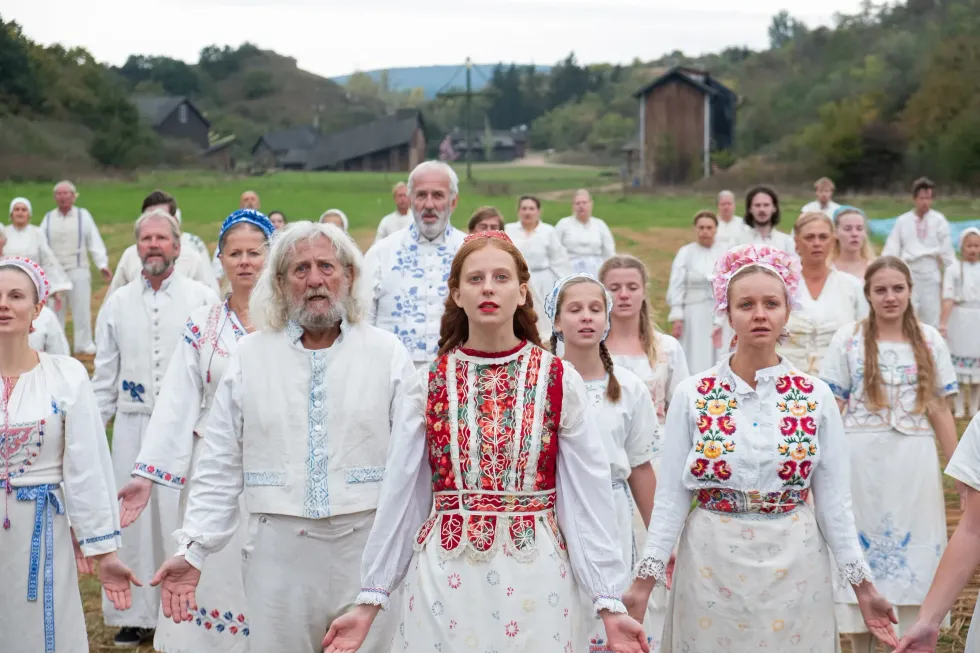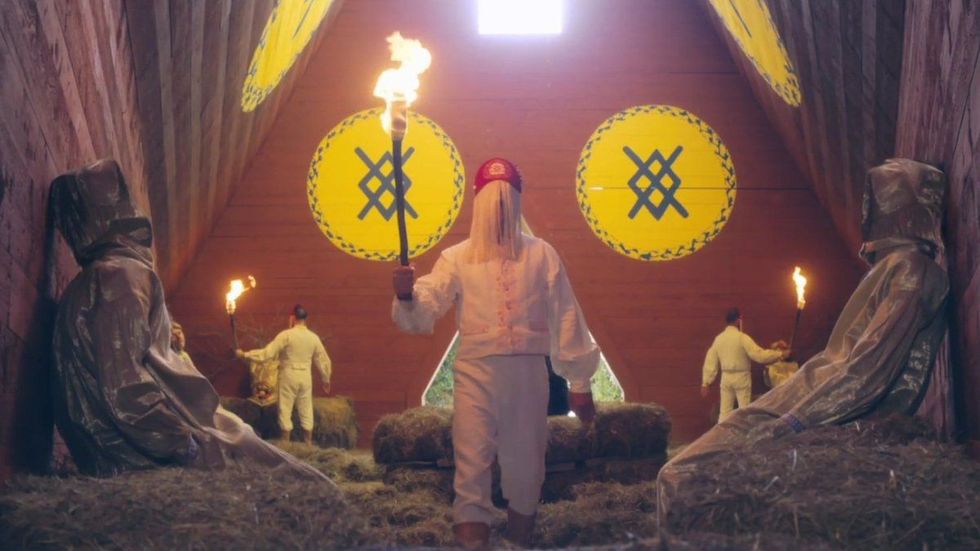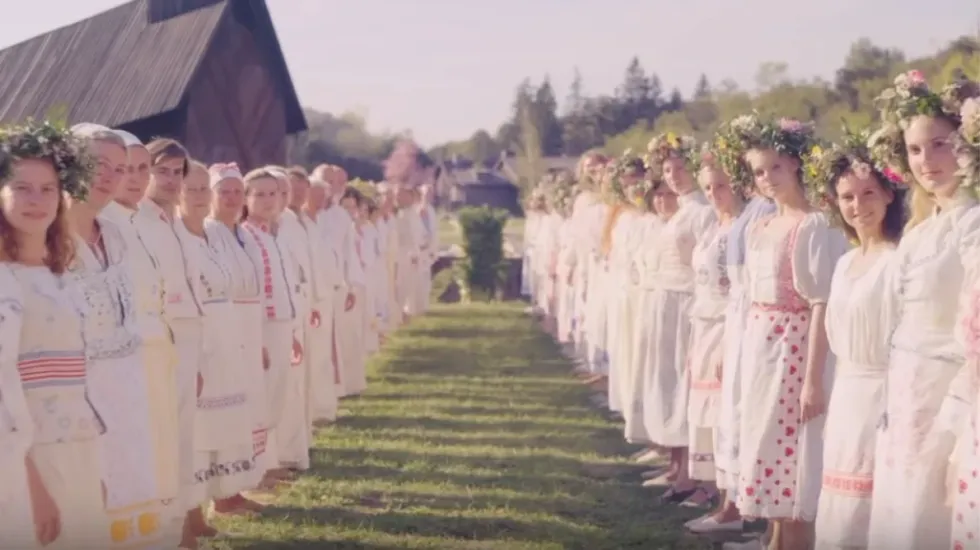The ‘Midsommar’ Ending Explained
Midsommar is a film that can make you feel liberated and manipulated, but why? Let's break down the ending to explain this bizarre, eerie feeling.

There is nothing more satisfying to me than a horror story that manipulates the protagonist into a contributing villain. Midsommardoes this through the blinding daylight sequences that do not hide the horrors of this small Swedish community in an ancestral commune in the woods.
The A24 daylight horror Midsommar, Ari Aster’s follow-up to his directorial debut Hereditary, took the world by storm, helping revive the folk horror genre while scaring us from stepping into the woods at any time of the day.
Although Aster describes the horror film as “a breakup movie dressed in the clothes of a folk horror film” to Vulture, the film’s meaning is purposefully complex, creating conversations about what the film is trying to tell us about isolating grief and rebirth.
Midsommar is distributing and difficult to watch since everyone is minutes away from a bad trip. Despite the heightened anxiety, the film is intriguing to watch, and it's always fun to discover the little ways the visual storytelling leads you through the story.
There is a lot to explain, so let’s see if we can discover the meaning of all of the psychedelic horrors we experience in Midsommar.
What does the ending of 'Midsommar' mean?
 Ari Aster on the set of 'Midsommar'
Ari Aster on the set of 'Midsommar'A24
“I keep telling people I want [the film] to be confusing,” Aster told Voxwhile discussing the strange story of Dani (Florence Pugh) and her seemingly endless struggle with grief. The events of the story are fairly easy to follow, but the ending is when things get a little wild, shocking, and confusing.
To fully understand the ending of Midsommar we have to understand what is happening throughout the film, particularly what shifts in Dani’s mental and emotional state, to fully understand the impact of that sadistic smile that Dani leaves us with.
The Midsommar Plot

'Midsommar'
A24
The opening scenes show us the two very different perspectives that American couple Dani and Christian (Jack Reynor) have of their relationship. Dani struggles with her outpour of emotions to build a stronger relationship with Christian, while he is clearly checked out and consistently emotionally unavailable to Dani.
Dani is aware of the distance growing between them, and feels like an emotional burden, telling her nameless friend over the phone that she is afraid that she is pushing him away, but her friend reminds her that a boyfriend is supposed to be supportive, and Christian is just a dick. Christian’s friends, Josh (William Jackson Harper) and Mark (Will Poulter), encourage him to end the relationship before Pelle (Vilhelm Blomgren) takes them on a trip to his ancestral commune in rural Hälsingland, Sweden.
Unfortunately, the double murder-suicide of Dani’s entire family throws a wrench into Christian’s plans to break up with Dani. Despite Dani being an emotional wreck and struggling with her grief, Christian cannot be the supportive boyfriend Dani needs because he is more bothered by the fact that he couldn’t break up with her now.
Things become more emotionally strained when Dani finds out that Christian and his friends are traveling to Sweden to celebrate the midsummer festival. He apathetically invites her, confident that she won’t go due to her massive recent trauma, but she does agree to travel with them. Christian’s friends are all frustrated except for Pelle, who tells Dani he is glad she is going but ends up triggering a panic attack in Dani after revealing that his entire family also died.
Once they arrive at the commune, they are met by British couple Connie (Ellora Torchia) and Simon (Archie Madekwe), students from London brought by Pelle’s brother, Ingemar (Hampus Hallberg). They all take psychedelic mushrooms, and Dani, unfortunately, ends up having a bad trip after Mark refers to the group as his family, and she begins to hallucinate about her deceased family.
She ends up falling asleep and wakes up to notice that it is still daylight, noting how the sun never sets where they are.
As the festivities begin, one of the villagers named Maja (Isabelle Grill) starts to flirt with Christain, which is the beginning of the commune's love ritual, further pulling Christain away from Dani. The next day, the group has supper with two elders as the guest of honor. After the meal, the two elders stand up and chant, take a shot, and are carried to a rocky landscape.
The group follows, only to unknowingly witness the Ättestupa, a ritualistic senicide that comes from Scandinavian folklore wherein elderly people throw themselves from a cliff to spare their community the burden of having to take care of them. The shocking scene shows the community's group empathy and a new perspective on death that helps Dani heal parts of her emotional wound.
At the end of the day, Dani is left feeling anxious and distressed, sneaking off to grieve alone, but the camera cuts before we see Dani break down, refusing to let her grief in the frame. Pelle finds Dani later packing her things, and tells her that the community collectively raised him and gave him a home after his family died, which he says is something Dani needs right now and isn’t getting from Christian.
The next day, Pelle tells Josh and Christian that they can do their theses on the Härga, provided they adhere to strict privacy restrictions. Christian begins his thesis by asking how the Härga avoid incest and is told that outsiders are brought in for mating purposes. While Josh is looking at the Rubi Radr, the holy scripture of the commune which is finger-painted by Ruben (Levente Puczkó-Smith) and translated by the elders.
At dinner, Dani questions if the Härga people are being truthful about Simon leaving Connie behind, but Dani then tells Christain that she could see him abandoning her like that. Christian gets a special meat pie with pubic hair in it and washes it down with a drink made by Maja to continue her love spell.
Mark is on edge because he disrespected the burial ground of the Härga, but is distracted by an attractive maiden who says she wants to show him something, taking him away from the group.
Bothered by Christain plagiarizing his thesis, Josh sneaks out of the barn while everyone is sleeping to take photos of the Rubi Radr, which goes against the wishes of the Härga. Ultimately, Josh is found by a Härga who is wearing Mark’s skin and is killed.
The next morning, the Härga leaders announce that Josh, Mark, and the Rubi Radr are missing. Christian is commanded to go see the Härga elder, Siv (Gunnel Fred), and Dani is instructed to join the ceremonial festivities. Dani dances in the May Queen competition while hallucinating on psychedelic mushroom tea as Christian is told by Siv that he is a good match for Maja, who wants to mate with him. Christian joins the spectators to watch the May Queen competition and drinks mushroom tea.
Christian watches from a distance as the commune gathers around to celebrate Dani for becoming the May Queen, and the drugs further distort Dani’s vision. After the feast, Dani is told to bless the crops while Christian is led to a building, drugged again, and has sex with Maja as the women of the commune watch and moan in unison with Maja.
Dani hears them when she gets back and discovers Christian having sex with Maja, which causes her to break down. The other women of the village tend to her and begin to cry with her, acknowledging and validating her emotional pain.
Understandably afraid after a moment of clarity, Christian runs outside and slowly discovers the corpses of the outsiders he arrived with. Christian is drugged again, waking up to find that he can’t speak or move.
Dani is asked to choose the ninth sacrifice—a randomly-selected Härga or her paralyzed, drugged, cheating boyfriend. Dani chooses Christian, and he is placed in a gutted bear, then burned with the other sacrifices in the temple. The commune and Dani watch as the temple burns. The Härga people screaming is supposed to show empathy for those burning alive inside the temple, and Dani watches, first horrified, and then she laughs.
A smile breaks across her face as Aster describes in the screenplay, "She... surrendered to a joy known only by the insane. She has lost herself completely, and she is finally free. It is horrible and it is beautiful."
Midsommar Ending Explained

'Midsommar'
A24
While Dani’s final expression can give us the impression that she has newfound happiness in her chosen family, the movie doesn’t shy away from showing us how the cult can manipulate and easily exploit those who are emotionally vulnerable.
In an interview with Let The Festivities Begin: Manifesting Midsommar, Aster said, “By the end, I guess I hope that people will feel moved and unsettled and confused.” The film lives up to Aster's hope, leaving us to decipher this specific feeling.
The Härga have their system of being, and while we, as viewers, might not always agree with the morality of their traditions and can see the faults in them, the Härga people have justified them, giving their actions a higher purpose that isn’t blatantly obvious at first. But that is what cults do.
Cults can be founded on ideas that are pure and simplistic, but the actions can lead to fearful events for the victims. When the fear rises, the leaders of the cult remind those who are fearful that what they are doing is the right thing and helps the group work toward a good cause.Aster manipulates the viewer into seeing the cult’s actions as beautiful and justified, keeping most of the horrors off-screen and asking us to look at the blinding beauty of the commune.
The Härga people reveal their true intentions throughout the film, but it's most clear when Dani, as the May Queen, has to pick the last sacrifice to conclude the festival—a random villager or her drugged ex-boyfriend.
Dani, who is an emotional mess at this point, chooses Christian because of very obvious reasons, but the Härga people place her in a position to condemn someone, familiar or unknown, to death for a summer festival that she has been manipulated into celebrating.
While this works thematically for Aster’s desire for a perverse break-up film, this moment is morally inexcusable. Aster is hyper-aware of this as the scene immediately cuts to the bloated corpse of Connie, reminding us that this cult has killed innocent people. This scene is not a “girl power” move, because the Härga people have complete control over the situation.
In the end, Dani is a victim of the cult. While she might feel some form of liberation, she is still trapped in a cult that will exploit her emotional trauma for their advantage.
The Purpose of Folk Horror

'Midsommar'
A24
Folk horror is a horror genre that has been thriving recently. If you are unfamiliar with the term, let me break it down for you.
Unlike most of the horror genre, which focuses on the horrors of people and urban life, folk horror finds its roots in rural life. It is difficult to convey the form that specifically makes a horror film a folk horror, but the emphasis on the evil that has seeped into the soil, the terror of the hidden or forgotten lands, and the unsettling force of nature over man.
MIdsommar is a quintessential modern folk horror film.
Aster emphasizes the unsettling nature of the land and the commune by disorienting the viewers with bright colors, blinding white costumes that are only broken by the clothing of the outsiders, and the low humming of the audiovisuals. Even the bright yellow temple radiates a fraudulent cheerfulness that immediately sends a shiver down everyone’s spine. The cheerful nature of the commune is broken by the stark contrast of blood from the elders, revealing that something darker lives beneath the surface.
Midsommar’s use of land isolates many viewers who are far removed from a rural lifestyle. It’s an otherworldliness that keeps the viewers just at the edge of fully understanding how the world of the film functions, requiring the weather to fully immerse themselves into the film for the entirety of its runtime.
The viewer sympathizes with Dani from the beginning to the end, often losing themselves in the spectacle of what is happening rather than realizing the moral implications of the cult’s actions. One of the ways this is done is through the murals presented throughout the film.
Explaining the Murals in Midsommar

'Midsommar' murals
A24
Production designer Henrik Svensson told Polygon in an interview, “All of the events seen throughout the film have happened many times before—at least every 90 years—and the murals are the Härga’s way of documenting this since none of the participants can be a part of this twice.”
Observant viewers might have expected certain moments of the film due to the Härga people communicating what is about to unfold through a series of paintings that preserve the traditions they’re carrying out.
“These murals," Svensson says, “are like a cartoon version of the script, twisted as we imagined the time would do to these rituals.”
A keen audience member could easily get spoiled in the film's first moments, but the murals in Midsommar still function well within the film.
“I think Sweden has a rich tradition of painting walls, usually they’ll reference everyday life—people harvesting the ground, and there’s a lot of Christianity as well,” Ragnar Persson, the Swedish artist who produced illustrations to fit the film’s rich mythology, said in an interview with Dazed magazine.
Many of Persson’s artwork uses blood and fire as “symbol[s] of connecting with nature.” He explains this idea further by discussing a scene that was cut from the final edit of the film.
“There was another scene where they have a ritual to see how far the harvest is going to go, so they blindfold [or remove the eyes of] two people who are walking backwards along the barn, and if the fire’s lit, it’s going to be a good year for the harvest. But if it’s out, it’s going to be a bad year,” Persson said.
Fire becomes a large motif throughout the story as well. As it engulfs Dani’s painful past, allowing her to be reborn, Persson understands the motif of fire as something that is always burning. “Maybe it’s society as a whole, like if they don’t take care of it, it’ll go out. It’s a community and you have to keep feeding it so that it carries on burning.”
The Power of Manipulation Throughout Midsommar

'Midsommar'
A24
In the end, Dani smiles at the memory of her past being set aflame, and we can’t help but relate to the cathartic moment. Why?
We shouldn’t feel pressured to feel as if the perspectives presented are entirely right or wrong. The film wants us to live in the ambiguity of it. Midsommar is cathartic because the commune constantly emotionally validates someone who doesn't have any support.
Movies are machines that generate empathy, and Midsommar is masterful at how it forces us to empathize with Dani from the start. She is isolated from her partner, has very few friends, and has no family. We want to be there for her, supporting the choices that will help her heal from the traumatic opening scene.When we get to the end, we can’t help but feel relief for Dani because she has found people who can validate her in a way we can’t. There’s just one issue… Dani and the viewers are being emotionally manipulated by the Härga.
The ending is complicated simply because the viewers’ wants are satisfied—Dani is happy, her bad boyfriend is gone, and she is surrounded by people who accept her—but when the situation is looked at from a wider perspective, the fear creeps in. Is this what we wanted?
It’s hard to say because Aster wanted the experience to be blurry. There are no solid answers to any of our questions, and the viewer is supposed to feel unnerved by the end. That’s the beauty of horror. Terrible actions can be justified, but that doesn’t mean that they are morally correct—but who are we to say what is and isn’t morally correct?
Do you have a different perspective on the ending of Midsommar?
Let us know your take in the comments below!
- A Deep Examination of the Final Girl Trope ›
- Why the Postmodern Structure of Ari Aster’s ‘Beau is Afraid’ Works Masterfully ›
- Learn How to Master Audiovisual Tricks from Midsommar ›













